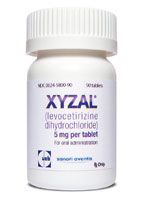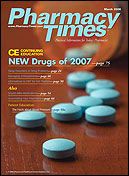Publication
Article
Pharmacy Times
Rx Product News Profile: A Closer Look at New FDA Actions: Xyzal
Author(s):
This antihistamine is approved for the treatment of allergic rhinitis and chronic idiopathic uticaria in patients aged 6 and older.
Dr. Holmberg is a pharmacy residentat the Carl T. Hayden Veterans AffairsMedical Center in Phoenix, Arizona.
UCB Inc and sanofiaventis' Xyzal

Xyzal (levocetirizine dihydrochloride)has received FDA approval for thetreatment of seasonal and perennialallergic rhinitis and uncomplicated skinmanifestations of chronic idiopathicurticaria. Xyzal is approved for use inpatients aged 6 and older; it offers aonce-daily dosing schedule and can betaken without regard to meals.1
The American Academy of Allergy,Asthma and Immunology estimatesthat up to 40 million Americans areaffected by allergies. Seasonal allergicrhinitis is the most common form ofallergic rhinitis and results from sensitivitiesto seasonal pollen (trees, grass,and weeds) and mold. Allergy symptomsthat last longer than 4 weeks andare triggered by allergens, such as dustmites, animal dander, and mold, arecharacterized as perennial allergicrhinitis. Chronic idiopathic urticaria isdefined as the presence of wheals anditching that occurs daily or almostdaily, lasts for at least 6 weeks, and hasno known cause.2
Mechanism of Action
Xyzal is an antihistamine and the activeenantiomer of cetirizine. It exertsits effect through inhibition of the H1receptors.1
Clinical Trials
Safety data for Xyzal 5 mg daily weredetermined by 12 randomized, placebo-controlledtrials in a total of 2549patients with either seasonal or perennialallergic rhinitis or chronic idiopathicurticaria. Trials were consideredeither short-term (duration of up to 6weeks) or long-term (duration 4-6months).1
FDA approval was based on 8 randomized,placebo-controlled trials inpatients aged 12 and older using Xyzal5 mg daily. Efficacy in the allergic rhinitisstudy was assessed by a significantimprovement in symptoms, such assneezing, rhinorrhea, nasal pruritus,and ocular pruritus, in the active treatmentgroup. When evaluated for efficacyin patients with idiopathic urticaria,symptoms, such as duration of pruritusand wheal size and quantity, werefound to be significantly improved inthe Xyzal group.3
The recommended dose of 2.5 mgfor children was not evaluated by clinicaltrials; instead, 2 short-term, placebo-controlledclinical trials evaluated the5-mg daily dose in a total of 243patients aged 6 to 12.1 The recommendeddose is based on an extrapolationof pharmacokinetics in adults andchildren.4
Dosing
Xyzal is manufactured as a 5-mgscored tablet. Because of its potentiallysedating effect, doses of Xyzalshould be administered in the evening.Patients aged 12 and older are recommendedto use 5 mg once daily in theevening; however, some patients mayexperience symptom relief with a lesserdose of 2.5 mg daily. Patients aged 6to 11 should use 2.5 mg once daily inthe evening; 2.5 mg is the maximumdaily dose in this age group.
In patients aged 12 and older withrenal impairment, the dose of Xyzalshould be adjusted according to creatinineclearance (CrCl) levels, as follows:
- CrCl 50 to 80 mL/min: 2.5 mg daily
- CrCl 30 to 50 mL/min: 2.5 mg every other day
- CrCl 10 to 30 mL/min: 2.5 mg twice weekly (every 3-4 days)1
Contraindications/Precautions
Xyzal is contraindicated in patientswith end-stage renal impairment asdefined by CrCl <10 mL/min or inpatients who are undergoing hemodialysis.Patients aged 6 to 11 withrenal impairment should not use Xyzal.Xyzal is contraindicated in patientswith a known hypersensitivity to any ofits components.
Patients are warned against usingXyzal during any activity that requiresalertness, such as driving or operatingheavy machinery. Patients should notuse alcohol or other central nervoussystem depressants while taking Xyzal.1
The most commonly reported adverseeffects in patients aged 12 andolder included somnolence, nasopharyngitis,pharyngitis, fatigue, anddry mouth. In patients aged 6 to 11, themost common adverse events reportedwere pyrexia, cough, somnolence,and epistaxis.4
References
- Xyzal Complete Prescribing Information. products.sanofi-aventis.us/Xyzal/Xyzal.pdf. Accessed October 2007.
- New prescription allergy treatment Xyzal (levocetirizine dihydrocholid) now available for fall allergy season [press release]. www.sanofi-aventis.us/live/us/medias/BB8FA299-85FA-4101-89AA-CC108767BEAB.pdf. Accessed October 2007.
- Waknin Y. FDA Approvals: Xyzal, Perforomist, Factive. Medscape Medical News. www.medscape.com/viewarticle/558154. Accessed October 2007.
- Young D. New hay fever, hives treatment approved. Am J Health-Syst Pharm. 2007;64:1352.







